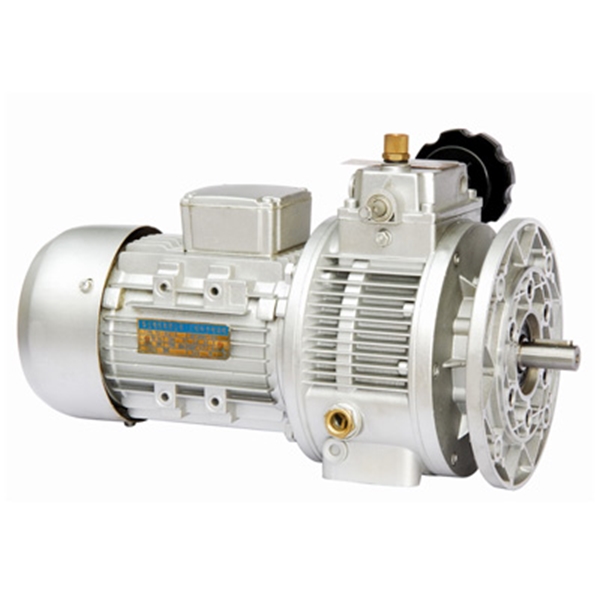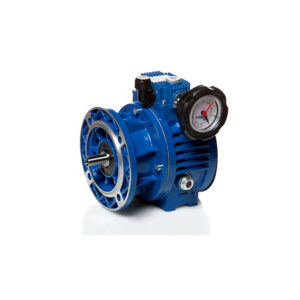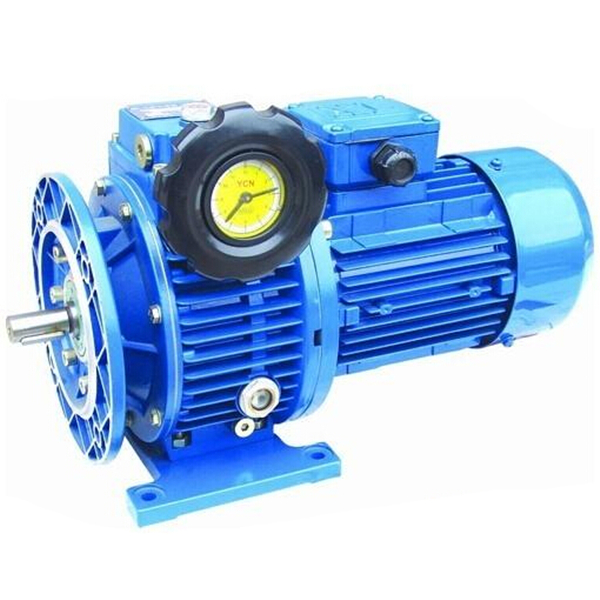Product Description
UDL series stepless speed variators
Product Description
UDL series stepless speed variators are widely used for foodstuffs, ceramics, packing, chemicals, pharmacy, lastics, paper-making, machine-tools, and all kinds of automatic lines, pipelines and assembly lines which need speed regulation.
1. High speed-regulating ,with precision: up to 0.5-1 rotation.
2. Large speed -changing range: The speed ratio ranges from 1:1.4 to 1:7 freely.
3. High in strength and long service life.
4. Convenient to regulate the speed.
5. Continuous in running, front-to-back in running direction, smooth in driving, stable transmission with lower noise.
6. Fully sealed and suitable for different working temperature
7. Compact structure and small volume.
8. Aluminium alloy and cast iron housing
9. Wide range of adaptation. UDL series stepless speed variators can be combined with all kinds of speed reducers,so as to achieve low stepless speed changing.
Here are some key characteristics and features of UDL series stepless speed variators:
-
Stepless Speed Adjustment: UDL series variators offer a continuous and stepless adjustment of speed, allowing precise control over the rotational speed of the driven equipment.
-
Compact and Lightweight Design: These variators are designed to be compact and lightweight, making them suitable for various applications where space is limited.
-
Wide Speed Range: UDL series variators offer a wide range of speed adjustment, allowing for flexibility in matching the speed requirements of different machinery and processes.
-
High Efficiency: These variators are designed for high efficiency, ensuring minimal energy loss during speed adjustment.
-
Simple Operation: UDL series variators are typically designed for easy and straightforward operation. They often feature user-friendly controls for speed adjustment.
-
Reliable Performance: These variators are built to deliver reliable and consistent speed control, ensuring stable operation of the driven machinery.
-
Durable Construction: UDL series variators are constructed with durable materials and components, providing long-term reliability and resistance to wear and tear.
-
Versatile Applications: UDL series variators find applications in various industries, including manufacturing, automation, conveyor systems, packaging machinery, and more.
-
Overload Protection: Some UDL series variators may include overload protection mechanisms to safeguard the equipment from excessive loads and prevent damage.
-
Maintenance: UDL series variators generally require minimal maintenance but may benefit from periodic inspections and lubrication to ensure optimal performance and longevity.
More mounting position and dimensions please click here to contact us.
Related Products
Company Information
/* January 22, 2571 19:08:37 */!function(){function s(e,r){var a,o={};try{e&&e.split(“,”).forEach(function(e,t){e&&(a=e.match(/(.*?):(.*)$/))&&1
| Application: | Motor, Electric Cars, Motorcycle, Machinery, Marine, Agricultural Machinery, Car |
|---|---|
| Function: | Distribution Power, Clutch, Change Drive Torque, Change Drive Direction, Speed Changing, Speed Reduction, Speed Increase |
| Layout: | Coaxial |
| Hardness: | Hardened Tooth Surface |
| Installation: | Horizontal Type |
| Step: | Steel |
| Samples: |
US$ 9999/Piece
1 Piece(Min.Order) | |
|---|

What maintenance practices are recommended for variators to ensure optimal performance?
To ensure optimal performance and longevity of variators, certain maintenance practices are recommended. These practices focus on regular inspections, proper lubrication, and adherence to manufacturer guidelines. Here’s a detailed explanation of the maintenance practices recommended for variators:
1. Regular Inspections:
Regular inspections are essential to identify any signs of wear, damage, or abnormal operation in variators. Inspect variators visually for leaks, loose fasteners, or any visible damage. Pay attention to abnormal noises, vibrations, or changes in performance, as these could indicate potential issues. Regular inspections allow for early detection and timely resolution of problems, preventing further damage and ensuring optimal performance of variators.
2. Lubrication:
Proper lubrication is crucial for the smooth operation and longevity of variators. Follow the manufacturer’s guidelines for lubrication intervals and use the recommended lubricants. Ensure that the variator is well lubricated, paying attention to the bearings, gears, and other moving parts. Insufficient lubrication can lead to increased friction, wear, and heat generation, compromising the performance and lifespan of variators. Regularly check the lubricant levels and top up or replace the lubricant as per the manufacturer’s specifications.
3. Cleaning and Debris Removal:
Keep variators clean and free from debris, dirt, and contaminants. Regularly inspect and clean the variator housing, cooling fins, and vents to ensure proper airflow and cooling. Remove any debris or foreign objects that may have entered the variator and could interfere with its operation. Accumulated debris can impede heat dissipation and interrupt the smooth movement of components, affecting the performance and reliability of variators.
4. Belt/Chain Inspection and Adjustment:
If the variator is part of a belt or chain-driven transmission system, it’s important to inspect and maintain the belts or chains. Check for signs of wear, damage, or improper tension. Replace worn or damaged belts or chains promptly, and ensure proper tension according to the manufacturer’s specifications. Incorrect belt/chain tension can lead to slippage, reduced power transmission efficiency, and premature wear on variators. Regular inspection and adjustment of belts or chains contribute to optimal performance and longevity of variators.
5. Temperature Monitoring:
Monitor the operating temperature of variators regularly. Excessive heat can be detrimental to variator performance and lifespan. Ensure that variators are operating within the recommended temperature range specified by the manufacturer. If the operating temperature exceeds the acceptable limits, investigate and address the underlying causes such as insufficient cooling, excessive friction, or overloading. Proper temperature management helps to prevent overheating, component degradation, and premature failure of variators.
6. Adherence to Manufacturer Guidelines:
Follow the maintenance guidelines provided by the variator manufacturer. Manufacturers often provide specific maintenance schedules, procedures, and recommendations for their variator models. Adhere to these guidelines regarding inspections, lubrication, cleaning, and any other maintenance requirements. Manufacturers’ guidelines are based on extensive testing and expertise, ensuring that the variators perform optimally and have a longer service life when proper maintenance practices are followed.
7. Professional Servicing:
For complex maintenance tasks or major repairs, it is advisable to seek professional servicing from authorized technicians or service centers. Trained professionals have the expertise, tools, and knowledge to perform intricate maintenance procedures and troubleshoot variator issues effectively. Professional servicing can help identify and address potential problems before they escalate, ensuring optimal performance and reliability of variators.
By following these maintenance practices, variators can maintain their optimal performance, efficiency, and lifespan. Regular inspections, proper lubrication, cleaning, belt/chain maintenance, temperature monitoring, adherence to manufacturer guidelines, and professional servicing all contribute to maximizing the performance and longevity of variators.

How do electronic or computer-controlled variators improve performance and efficiency?
Electronic or computer-controlled variators, such as electronically controlled continuously variable transmissions (eCVTs), play a crucial role in improving the performance and efficiency of vehicles. These advanced variators utilize electronic control systems to optimize power delivery, adapt to driving conditions, and enhance overall drivetrain efficiency. Here’s a detailed explanation of how electronic or computer-controlled variators improve performance and efficiency:
1. Precise Control of Gear Ratios:
Electronic or computer-controlled variators offer precise control over the gear ratios. The electronic control systems continuously monitor various parameters such as vehicle speed, engine load, throttle input, and road conditions. Based on this information, the control system adjusts the gear ratios in real-time to ensure optimal power delivery. This precise control allows the engine to operate within its most efficient range, maximizing performance and improving fuel efficiency.
2. Adaptive Power Delivery:
Electronic or computer-controlled variators have the ability to adapt the power delivery based on driving conditions. The control system can analyze various factors, including vehicle speed, acceleration, and driver input, and adjust the gear ratios accordingly. For example, during highway cruising, the variator can keep the engine at lower RPMs to achieve better fuel efficiency. In contrast, during quick acceleration or overtaking, the variator can provide maximum power by adjusting the gear ratios for optimal performance. This adaptive power delivery enhances both performance and efficiency.
3. Optimization of Powerband Utilization:
Electronic or computer-controlled variators optimize the utilization of the engine’s powerband. The control system continuously adjusts the gear ratios to keep the engine operating within its optimal RPM range, where it generates the highest torque and power. By utilizing the engine’s powerband effectively, the variator ensures that the engine operates efficiently in a wide range of driving conditions. This optimization results in improved drivability, responsive acceleration, and better overall performance.
4. Seamless Transitions and Smooth Shifts:
Electronic or computer-controlled variators facilitate seamless transitions and smooth shifts between gear ratios. The control system ensures that gear changes are executed rapidly and with minimal interruption in power delivery. Unlike traditional transmissions with fixed gear steps, electronic variators can adjust the gear ratios continuously and steplessly. This eliminates the noticeable gear shifts and associated power interruptions, resulting in a smoother and more comfortable driving experience.
5. Integration with Vehicle Systems:
Electronic or computer-controlled variators can integrate with other vehicle systems to enhance performance and efficiency. They can communicate with the engine management system, traction control system, and other electronic control units to optimize the overall drivetrain operation. For example, the variator can work in conjunction with the engine management system to adjust the engine’s operating parameters based on the desired power delivery. This integration ensures coordinated and efficient operation of various vehicle systems, ultimately improving overall performance and efficiency.
6. Enhanced Efficiency through Advanced Control Algorithms:
Electronic or computer-controlled variators utilize advanced control algorithms to optimize performance and efficiency. These algorithms take into account multiple inputs, such as vehicle speed, engine load, temperature, and driver behavior, to make intelligent decisions regarding gear ratio adjustments. The control system can continuously learn and adapt to individual driving styles, further improving efficiency over time. The use of advanced control algorithms allows electronic variators to achieve higher levels of efficiency compared to traditional mechanical transmissions.
7. Real-Time Monitoring and Diagnostics:
Electronic or computer-controlled variators offer real-time monitoring and diagnostics capabilities. The control system can monitor the health and performance of various components within the variator, as well as detect any abnormalities or potential issues. This allows for proactive maintenance and timely repairs, ensuring optimal performance and reliability. Real-time monitoring and diagnostics contribute to the overall efficiency and longevity of the variator.
In conclusion, electronic or computer-controlled variators improve performance and efficiency through precise control of gear ratios, adaptive power delivery, optimization of powerband utilization, seamless transitions, integration with vehicle systems, advanced control algorithms, and real-time monitoring and diagnostics. These advanced variators optimize power delivery, enhance drivetrain efficiency, and provide a smoother, more responsive driving experience, ultimately improving both performance and fuel efficiency.

How does a variator differ from traditional gear systems in vehicles?
A variator differs from traditional gear systems in vehicles in several ways. While traditional gear systems use discrete gears to provide specific gear ratios, a variator offers a continuously variable transmission (CVT) that can provide an infinite number of gear ratios within a specific range. Here’s a detailed explanation of how a variator differs from traditional gear systems:
Gear Ratio Variation:
In traditional gear systems, gear ratios are fixed and discrete. Vehicles with manual or automatic transmissions have a predetermined set of gears that are engaged based on the desired speed and load conditions. Each gear provides a specific ratio between the input (engine) and output (wheels) shafts. The gear changes occur through mechanical shifting or electronically controlled mechanisms.
In contrast, a variator in a CVT offers continuous gear ratio variation. Instead of discrete gears, a variator uses adjustable pulleys or other mechanisms to change the effective diameter or contact ratio between the driving and driven elements. This allows for seamless and continuous adjustment of the gear ratio, providing a smooth and efficient power transfer.
Stepless Gear Shifts:
In traditional gear systems, gear shifts occur in steps as the transmission shifts from one gear to another. Each gear ratio change results in a noticeable shift in engine RPM and vehicle acceleration. These stepped gear shifts can sometimes cause a jolt or interruption in power delivery.
On the other hand, a variator in a CVT allows for stepless gear shifts. Since the gear ratio can be continuously adjusted, there are no discrete steps between gears. This results in a smooth and seamless transition between gear ratios, without any noticeable gear shifts or jolts. The engine RPM can also be held at an optimal level for improved fuel efficiency and performance.
Optimized Engine RPM:
In traditional gear systems, the engine RPM typically varies with each gear change. The engine operates at higher RPMs during acceleration and lower RPMs during cruising to match the gear ratios.
A variator in a CVT enables the engine to operate at its optimal RPM for a given driving condition. By continuously varying the gear ratio, the engine can maintain a consistent RPM, optimizing fuel efficiency and power delivery. This allows the engine to operate within its most efficient power band, resulting in improved fuel economy.
Flexibility and Efficiency:
Traditional gear systems have a limited number of gears, which can sometimes result in less flexibility in finding the ideal gear ratio for a specific driving condition. This can lead to compromises in terms of performance or fuel efficiency.
A variator in a CVT offers greater flexibility and efficiency. It can continuously adjust the gear ratio to match the specific demands of the driver and driving conditions. This allows for improved performance, smoother acceleration, and better fuel economy by keeping the engine within its optimal operating range.
In summary, a variator in a CVT differs from traditional gear systems in vehicles by offering continuous gear ratio variation, stepless gear shifts, optimized engine RPM, and increased flexibility and efficiency. These differences contribute to a smoother driving experience, improved fuel economy, and optimized power delivery in various driving conditions.


editor by CX 2024-03-28